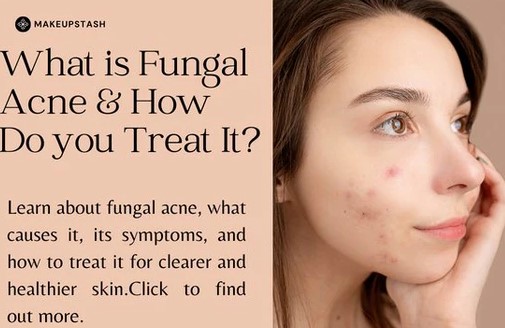BOURSESSENEGAL – Fungal acne, often misunderstood, is a skin condition that can be both frustrating and challenging to manage. Unlike traditional acne, fungal is caused by an overgrowth of yeast on the skin. Understanding fungal acne is crucial for effective treatment and prevention. In this comprehensive guide, we’ll explore the causes, symptoms, and the best treatment options available. Whether you’ve just started noticing symptoms or have struggled for a while, this article aims to provide you with valuable insights and practical solutions.
Defining Fungal Acne
Fungal acne, medically known as Malassezia folliculitis, occurs when the Malassezia yeast, which naturally resides on our skin, overgrows. This condition resembles traditional acne but requires different treatment approaches. It often appears as small, itchy bumps that can be mistaken for regular pimples, leading to confusion among those affected.
How Fungal Acne Differs from Regular Acne
While both conditions can manifest similarly, the underlying causes differ significantly. Regular acne usually results from clogged pores, excess oil production, and bacteria. In contrast, fungal acne stems from an imbalance in the skin’s natural flora. Understanding this distinction is vital for effective treatment.
Identifying the Symptoms of Fungal Acne
Common Signs to Look For
Recognizing the symptoms of fungal acne can help you address the issue early on. Common signs include:
- Small, red, or flesh-colored bumps.
- Itching or burning sensations.
- Bumps that are typically uniform in size and often clustered together.
- Pustules that may resemble acne but do not respond to typical acne treatments.
Areas Most Affected
Fungal acne frequently appears on areas prone to sweating, such as the chest, back, and shoulders. It can also occur on the face. If you notice persistent bumps in these regions, it may be time to consider the possibility of fungal.
The Role of Malassezia Yeast
Malassezia yeast is a type of fungus that naturally lives on our skin. Various factors can lead to its overgrowth, resulting in fungal acne. Understanding these causes can help prevent outbreaks and manage existing conditions.
Factors Contributing to Overgrowth
- Humidity and Sweat: Hot, humid weather creates an ideal environment for yeast to thrive. Excessive sweating can exacerbate the problem.
- Oily Skin: Individuals with oily skin are more susceptible to fungal, as the excess oil provides nourishment for the yeast.
- Antibiotic Use: Antibiotics can disrupt the balance of bacteria on the skin, allowing yeast to proliferate.
- Certain Skin Products: Some skincare products, especially those containing heavy oils or occlusive ingredients, can feed the yeast and contribute to breakouts.
Effective Treatments for Fungal Acne
Over-the-Counter Solutions
If you suspect you have fungal acne, several over-the-counter treatments can help. Look for products containing the following active ingredients:
- Ketoconazole: An antifungal agent that targets the Malassezia yeast directly.
- Clotrimazole: Another antifungal that can help restore balance to the skin.
- Selenium sulfide: Often found in dandruff shampoos, it can be effective when applied to the affected areas.
Prescription Treatments
In more severe cases, a dermatologist may prescribe stronger antifungal medications. These can include oral antifungal treatments or topical solutions that specifically target fungal acne. It’s essential to consult with a healthcare professional for a tailored approach.
Lifestyle Changes for Prevention
In addition to topical treatments, making certain lifestyle changes can significantly reduce the risk of fungal acne. Consider the following:
- Wear Breathable Fabrics: Choose loose-fitting clothing made from natural fibers to allow your skin to breathe and reduce sweat buildup.
- Shower After Sweating: Rinse off after workouts or activities that cause sweating to eliminate excess moisture and yeast buildup.
- Avoid Heavy Skincare Products: Steer clear of products with heavy oils or comedogenic ingredients that can worsen fungal.
Skincare Routine Adjustments
Adjusting your skincare routine is crucial in managing fungal . Here are some tips:
- Use Non-Comedogenic Products: Look for skincare and makeup labeled as non-comedogenic to prevent clogged pores.
- Incorporate Antifungal Ingredients: Add antifungal cleansers or toners to your regimen to help control yeast levels on your skin.
- Keep Your Skin Clean and Dry: Regular cleansing helps maintain skin hygiene, while drying off thoroughly after washing can prevent moisture buildup.
When to See a Dermatologist
Persistent Symptoms
If you’ve tried over-the-counter treatments without improvement, it may be time to consult a dermatologist. Persistent symptoms, such as itchy bumps that don’t respond to typical acne treatments, warrant professional evaluation.
Personalized Treatment Plans
A dermatologist can provide a tailored treatment plan based on your specific skin type and condition. They may also recommend advanced therapies, such as laser treatments or prescription medications, to help you achieve clearer skin.
Myths and Misconceptions About Fungal Acne
Common Misunderstandings
Misunderstandings about fungal acne can lead to ineffective treatments and frustration. Here are some common myths:
- Myth 1: Fungal is just regular acne.
Fact: Fungal requires different treatment approaches due to its unique cause. - Myth 2: You can treat fungal with regular acne products.
Fact: Traditional acne treatments often exacerbate fungal.
Understanding Your Skin
Educating yourself about the condition can empower you to make informed choices. Understanding what works for your skin and what doesn’t is essential in your journey toward clearer skin.
Conclusion: Embracing Healthy Skin
Navigating the challenges of fungal acne can be frustrating, but armed with knowledge, you can find effective solutions. By understanding the causes, recognizing symptoms, and implementing appropriate treatments, you can manage this condition more effectively.
Remember, skincare is a journey. It’s essential to be patient and consistent with your routine. If you find yourself struggling, don’t hesitate to seek professional help. Clear skin is achievable, and with the right approach, you can embrace your skin with confidence.
With this comprehensive understanding of fungal , you’re better equipped to tackle any outbreaks and maintain healthy, glowing skin. Stay informed, and take care of your skin—it’s your most valuable asset!
REFERENCE : https://www.cdcfoundation.org/



